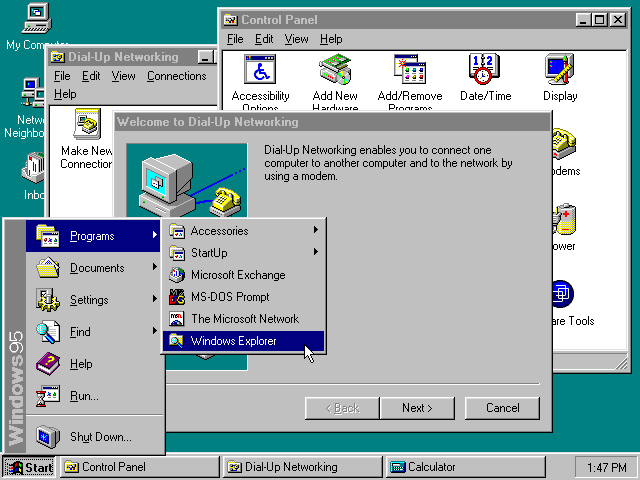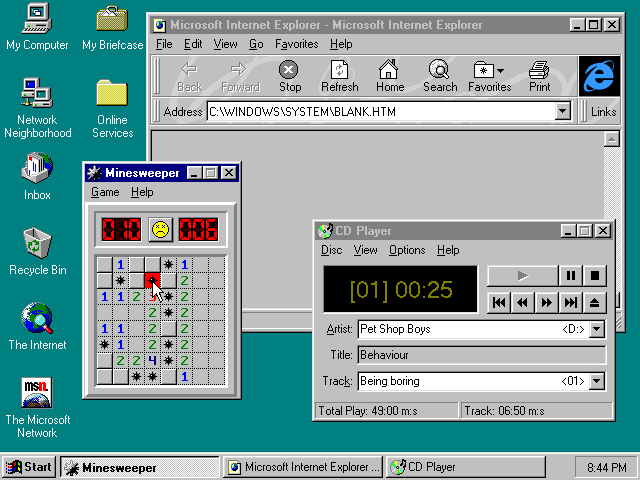Windows 95 integrated Microsoft's formerly seperate MS-DOS and Windows products. It featured significant improvements over its predecessor (Windows 3.1), most notably in the graphical user interface (GUI) and in its relatively simplified plug-n-play features. It introduced the Start button, something which would later be introduced in every version of Windows, up to Windows 8 (reintroduced in Windows 8.1). It also introduced the Taskbar, which still remains in Windows to this day. Windows 95 was a major success in the marketplace, and, within a few weeks, became the most used operating system in the world. Support for Windows 95 officially ended on December 31, 2001.
Features
Windows 95 has several features not present in Windows 3.1 or any of the predecessors.
Long File Names
32-bit File Access is necessary for the long file names feature introduced with Windows 95 through the use of the VFAT file system extension. It is available to both Windows programs and MS-DOS programs started from Windows (they have to be adapted slightly, since accessing long file names requires using larger pathname buffers and hence different system calls). Competing DOS-compatible operating systems released before Windows 95 cannot see these names. Using older versions of DOS utilities to manipulate files means that the long names are not visible and are lost if files are moved or renamed, as well as by the copy (but not the original), if the file is copied. During a Windows 95 automatic upgrade of an older Windows 3.1 system, DOS and third-party disk utilities which can destroy long file names are identified and made unavailable. When Windows 95 is started in DOS mode, e.g. for running DOS programs, low-level access to disks is locked out. In case the need arises to depend on disk utilities that do not recognize long file names, such as MS-DOS 6.x's defrag utility, a program called LFNBACK for backup and restoration of long file names is provided on the CD-ROM. The program is in the \ADMIN\APPTOOLS\LFNBACK directory of the Windows 95 CD-ROM.
32-bit
Windows 95 followed Windows for Workgroups 3.11 with its lack of support for older, 16-bit x86 processors, thus requiring an Intel 80386 (or compatible). While the OS kernel is 32-bit, much code (especially for the user interface) remained 16-bit for performance reasons as well as development time constraints (much of Windows 95's UI code was recycled from Windows 3.1). This had a rather detrimental effect on system stability and led to frequent application crashes.
The introduction of 32-bit File Access in Windows for Workgroups 3.11 meant that 16-bit real mode MS-DOS is not used for managing the files while Windows is running, and the earlier introduction of the 32-bit Disk Access means that the PC BIOS is often no longer used for managing hard disks. DOS can be used for running old-style drivers for compatibility, but Microsoft discourages using them, as this prevents proper multitasking and impairs system stability. Control Panel allows a user to see what MS-DOS components are used by the system; optimal performance is achieved when they are bypassed. The Windows kernel uses MS-DOS style real-mode drivers in Safe Mode, which exists to allow a user to fix problems relating to loading native, protected-mode drivers.
Internet Explorer
Windows 95 originally shipped without Internet Explorer, and the default network installation did not install TCP/IP, the network protocol used on the Internet. At the release date of Windows 95, Internet Explorer 1.0 was available, but only in the Plus! add-on pack for Windows 95, which was a separate product. The Plus! Pack did not reach as many retail consumers as the operating system itself (it was mainly advertised for its add-ons such as themes and better disk compression) but was usually included in pre-installed (OEM) sales, and at the time of Windows 95 release, the web was being browsed mainly with a variety of early web browsers such as Netscape (promoted by products such as Internet in a Box).
Windows 95 OEM Service Release 1 was the first release of Windows to include Internet Explorer (version 2.0) with the OS. While there was no uninstaller, it could be deleted easily if the user so desired. OEM Service Release 2 included Internet Explorer 3. The installation of Internet Explorer 4 on Windows 95 (or the OSR2.5 version preinstalled on a computer) gave Windows 95 active desktop and browser integration into Windows Explorer, known as the Windows Desktop Update. The CD version of the last release of Windows 95, OEM Service Release 2.5 (Version 4.00.950C), includes Internet Explorer 4, and installs it after Windows 95's initial setup and first boot is complete.
Only the 4.x series of the browser contained the Windows Desktop Update features, so anyone wanting the new shell had to install IE4 with the desktop update before installing a newer version of Internet Explorer. The last version of Internet Explorer supported on Windows 95 is Internet Explorer 5.5 which was released in 2000. Windows 95 shipped with Microsoft's own dial-up online service called The Microsoft Network.
Downloads
Windows 95 RTM Upgrade (English) (x86)
Windows 95 RTM CD (English) (x86)
Windows 95B CD (English) (x86)
Windows 95C CD (English) (x86)
After that you can just put the files on a Floppy disk or a CD-ROM and install Windows 95 on a computer, or you can use Virtualbox to emulate it.
Windows 95B and Windows 95C require a serial key to operate fully. Certain versions of the standard version (Windows 95A) do not. Because no Windows 95 versions or variants are available for purchase by Microsoft whatsoever, and none of Windows 95 versions or variants are supported, it is officially considered abandonware, Therefor we can legally provide serial keys for the software that you can use. We do ask that you please buy Windows 95 to support Microsoft, however!
Serial Keys
OSR2: 31795-OEM-0006627-29381
OSR1: 757-2573155
95 Original (if needed): 875-7215850
Info
Developed by: Microsoft Corporation
Release date: August 24, 1995
Latest version: 4.0 (Released in November 26, 1997)
Source model: Closed source
License: Commercial software
Preceded by: Windows 3.1 (in 1992)
Succeeded by: Windows 98 (in 1998)
Support status: Unsupported as of December 31, 2001
System requirements:
Intel 80386 DX CPU or higher
4 MB of RAM
70 MB Hard Drive with at least 50-55 MB of space available
VGA or higher resolution (EGA still possible using graphics drivers from Windows 3.11)
Recommended Downloadable programs
Windows 95 can download programs. You can click on the links below and simply put the files on your floppy disk or CD-Rom.
Screenshots



No comments:
Post a Comment